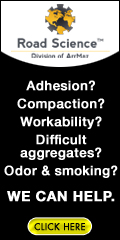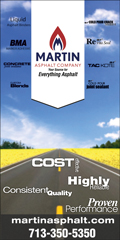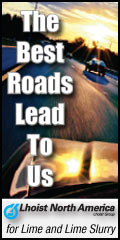| Tuesday, March 1, 2016 | ||
 |
 |
 |
| Past Issues | www.texasasphalt.org | Printer-Friendly | Subscribe | Advertise |
Environmental, Health and Safety Brief
Safety
FYI...Remember your OSHA 300 log should have been posted beginning Feb. 1. OSHA’s New Injury Reporting Rule Although OSHA’s new injury reporting rule has been in effect for less than a year, it has caused some major changes in the way that OSHA operates. Since the new reporting rule went into effect on Jan. 1, 2015, OSHA has received 200 to 250 reports of work-related deaths, inpatient hospitalizations, amputations and losses of an eye each week—or about 12,000 reports for the year.
Around 40 percent of the newly filed reports have prompted OSHA inspections. Another 46 percent have resulted in what the agency refers to as a "rapid response investigation." In a rapid response investigation, OSHA contacts the reporting employer and instructs the employer to investigate the root cause of the incident, determine how to prevent similar incidents from happening in the future and report these findings back to OSHA in about a week.
When OSHA is dissatisfied with an employer’s response—such as reports that merely blame the victim—it will proceed to conduct its own inspection of the incident. Accordingly, now more than ever, it is vital for employers to understand how to conduct an effective root cause analysis and produce an effective investigation report that will help them prevent similar incidents from taking place in the future.
Departments of Labor and Justice launch initiative to cooperate on investigation and prosecution of workplace safety violations
The initiative strengthens the ability of the two departments to investigate and prosecute employers who fail to provide a safe workplace for their employees. The Memorandum of Understanding calls for the Justice Department and the U.S. Attorney's Offices to work with the Department of Labor's Occupational Safety and Health Administration (OSHA) and the Mine Safety and Health Administration (MSHA) to investigate and prosecute worker endangerment violations. Currently, the worker safety statutes generally provide for only misdemeanor penalties, whereas the new initiative will encourage them to use the federal criminal and penal code and environmental offenses, which often occur in conjunction with worker safety crimes, to enhance penalties and increase deterrence.
U.S. Companies Pay $62 Billion Per Year for Workplace Injuries
Workplace injuries and accidents that cause employees to miss six or more days of work cost U.S. employers nearly $62 billion in 2013, the most recent year for which statistically valid injury data is available from the U.S. Bureau of Labor Statistics (BLS) and the National Academy of Social Insurance. That is more than $1 billion per week spent on the most disabling, nonfatal workplace injuries.
When the indirect costs of workers' compensation claims are added to the $38.7 billion in direct costs identified by the report, the total economic burden of workplace injuries and illnesses is far greater, with estimates ranging between $125 billion to $155 billion, according to a recent Liberty Mutual report.
The leading causes of workplace injuries and illness that resulted in employees missing five or more days of work are:
•overexertion;
•falls on same level;
•falls to lower level;
•being struck by an object;
•repetitive motion;
•highway accidents;
•being struck against an object;
•being caught in or compressed by equipment;
•contact with temperature extremes
Environmental
For those of you that attended the January EHS Seminar, here is the contact information for;
Remember that Storm Water Discharge Monitoring Reports (DMR’s) are coming due. DMRs are to be submitted to TCEQ by March 31 of each year if you meet one or both of the following cases:
Tier II reporting is coming up with reports due to the TCEQ on March 1, 2016. Reporting is done for each facility on an annual basis and is required under both federal and state law. You are required to report the hazardous materials you had on site during the previous calendar year that were at, or above, the reporting threshold of 10,000 pounds, or for Extremely Hazardous Substances the Threshold Planning Quantity (TPQ) or 500 pounds, whichever is the lesser amount.
Health
PEL – What is it? Most of us have to comply with and operate within certain exposure constraints for chemicals, dust, vapors etc. One of the terms used to define exposure levels is the PEL. This stands for Permissible Exposure Level (or Limit) and is the numerical value that defines the level in the air where exposure to a substance becomes a health concern. Generally, the PEL is given in terms of some amount of a substance per unit of volume or mass (example: parts per million or grams per cubic meter). If the concentration of the substance goes above the PEL then we have to figure out a way to protect our exposed employees by either engineering out the exposure hazard or by minimizing it such that the exposure remains below the PEL. You will hear more of this when regulations such as the proposed Silica Rule become final. Also note that your insurance carrier may be able to help you with determining if your employees are at risk of over exposure to substances that are a part of their workplace. Quite often this exposure monitoring service is provided free of charge as a benefit of being insured by the insurance company. |
Asphalt: Smooth | Durable | Quiet | Safe





